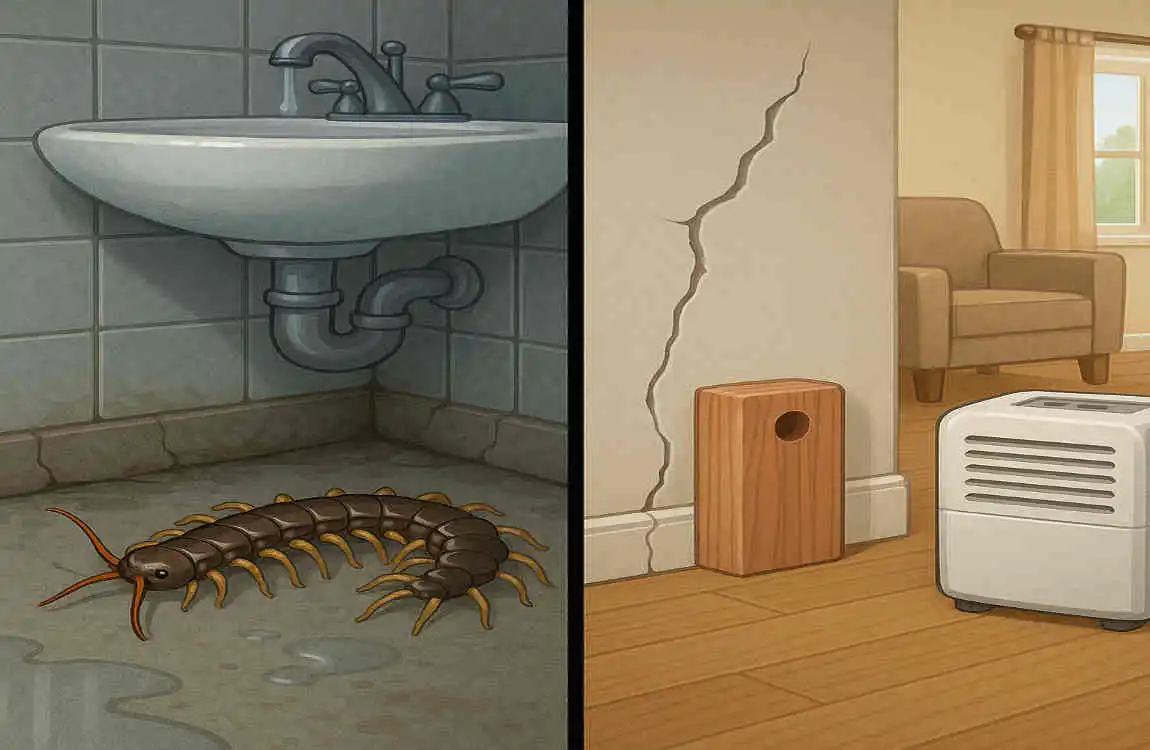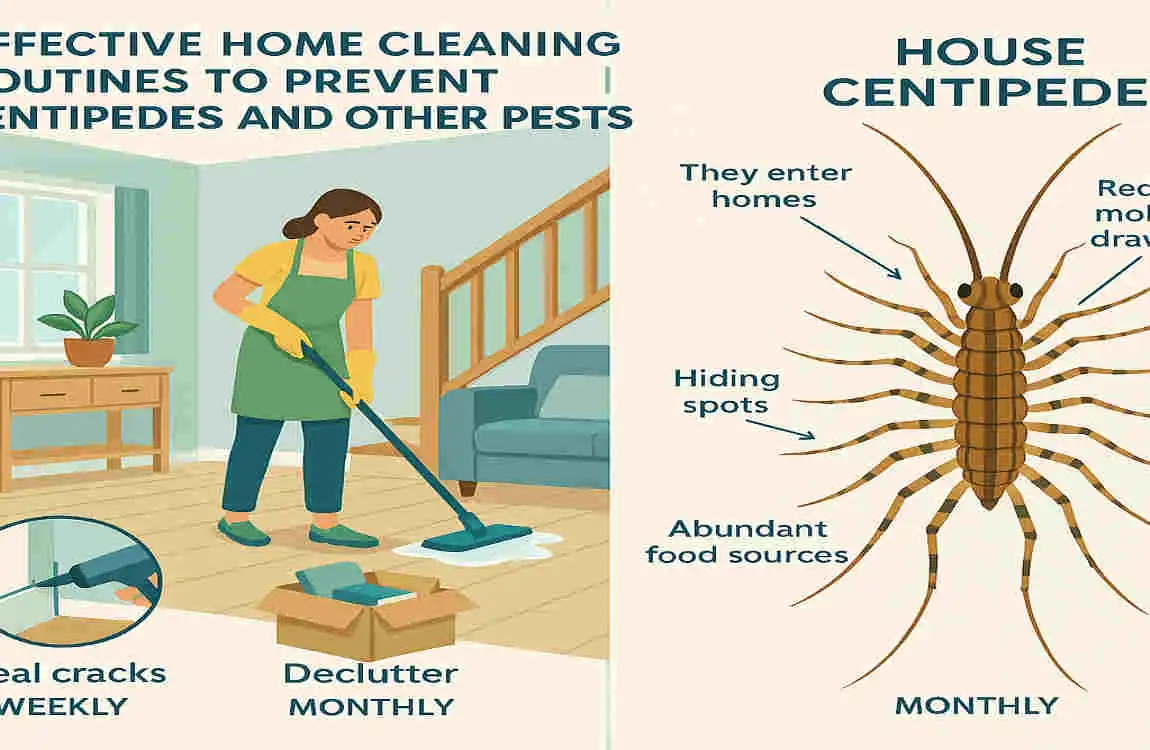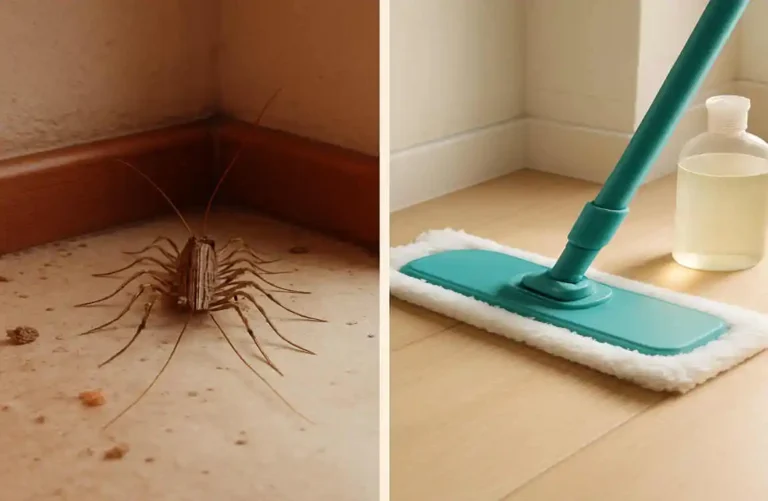Ever spotted a creepy crawly centipede scurrying across your floor? These multi-legged critters can send shivers down your spine, but did you know they might be a sign of underlying issues in your home? Centipedes often appear in houses due to excess moisture or an abundance of their prey, like insects and spiders. If you’re dealing with these unwelcome visitors, don’t worry – we’ve got you covered.
Understanding Centipedes and Why They Enter Homes

Common Centipede Species Found in Houses
The house clean centipede is known for its long legs and fast movement, while the soil centipede is more robust and often found in damp areas.
Habitats and Behaviors That Bring Centipedes Indoors
Centipedes are attracted to moist environments and often enter homes through cracks, gaps, or open doors and windows. They seek shelter from extreme temperatures and hunt for their prey, which includes other insects and spiders. If your home provides a suitable habitat with ample food sources, centipedes may decide to stick around.
Why Centipedes Are Not Typically Harmful to Humans but Indicate Moisture or Insect Problems
While centipedes may look intimidating, they are generally not harmful to humans. They don’t transmit diseases and rarely bite unless provoked. However, their presence in your home can indicate underlying issues, such as excess moisture or an insect infestation. By addressing these problems, you can create an environment that’s less welcoming to centipedes.
Signs of an Infestation Beyond Sight: Shed Skins, Egg Cases, Increased Sightings
Apart from actually seeing centipedes, there are other signs that may indicate an infestation. Keep an eye out for shed skins, which centipedes leave behind as they grow, and egg cases, which are often found in dark, damp areas. If you start noticing an increase in centipede sightings, it’s a clear indication that you need to take action to address the problem.
Baseline Housekeeping to Deter Centipedes
Decluttering and Removal of Hidden Moisture Sources
One of the first steps in preventing centipede infestations is to declutter your home and remove any hidden moisture sources. Piles of clutter provide hiding spots for centipedes and their prey, while damp areas create an inviting environment for these critters. Take the time to organize your belongings, fix any leaks, and ensure proper ventilation in areas prone to moisture, such as bathrooms and basements.
Regular Dusting and Vacuuming Routines to Reduce Prey Insects
Centipedes feed on other insects and spiders, so reducing the population of their prey can help deter them from entering your home. Establish a regular dusting and vacuuming routine to remove dust, debris, and any potential food sources for insects. Pay special attention to corners, baseboards, and under furniture, as these are common hiding spots for pests.
Floor Care Essentials: Sweeping High-Traffic Zones, Mopping Schedules, and Humidity Control
Keeping your floors clean is crucial in preventing centipede infestations. Make sure to sweep high-traffic zones daily to remove any dirt, crumbs, or debris that may attract insects. Establish a mopping schedule, focusing on areas where moisture tends to accumulate, such as kitchens and bathrooms. Additionally, control humidity levels in your home by using dehumidifiers or improving ventilation to create an environment that’s less appealing to centipedes.
Storage Changes: Sealing Cardboard Boxes, Organizing Storage Areas to Reduce Hiding Spots
Centipedes love to hide in dark, damp places, and cardboard boxes provide the perfect habitat. To reduce potential hiding spots, seal any cardboard boxes and store them off the floor. Consider switching to plastic storage containers, which are less attractive to centipedes. Organize your storage areas to minimize clutter and make it easier to spot any signs of an infestation.
Deep Cleaning Protocols Tailored to Prevent Centipede Infestations
Entry Point Elimination: Sealing Gaps Around Doors, Windows, Pipes, and Vents
One of the most effective ways to prevent centipedes from entering your home is to eliminate their entry points. Inspect your doors, windows, pipes, and vents for any gaps or cracks and seal them using caulk or weather stripping. By creating a barrier between your home and the outside world, you’ll significantly reduce the chances of centipedes finding their way indoors.
Floor Cleaning Strategies by Surface Type
Hardwood and Laminate Floors: Routine Sweeping, Damp Mopping, and Humidity Management
If you have hardwood or laminate floors, regular sweeping is essential to remove any dirt or debris that may attract insects. Damp mop your floors weekly, using a mild cleaner to avoid damaging the surface. Keep an eye on humidity levels, as excess moisture can lead to warping or buckling of the flooring, creating potential hiding spots for centipedes.
Tile and Stone Floors: Grout Cleaning and Sealing to Reduce Microhabitats
Tile and stone floors can provide microhabitats for centipedes, especially in the grout lines. Regularly clean the grout using a grout brush and a mild cleaner to remove any dirt or mold that may attract insects. Consider sealing the grout to make it easier to clean and less inviting to pests. By maintaining your tile and stone floors, you’ll create a less hospitable environment for centipedes.
Carpets and Area Rugs: Thorough Vacuuming with High-Suction Settings and Carpet Shampooing
Carpets and area rugs can harbor dust, dirt, and insects, making them attractive to centipedes. Vacuum your carpets and rugs thoroughly, using high-suction settings to remove any debris or potential food sources for pests. Consider shampooing your carpets periodically to deep clean and remove any hidden insects or eggs. By keeping your carpets and rugs clean, you’ll reduce the chances of centipedes finding a suitable habitat in your home.
Kitchen Cleanup to Reduce Arthropod Prey: Wiping Countertops, Cleaning Under Appliances, and Trap-Free Pantry Organization
The kitchen is a prime target for centipedes due to the abundance of food sources and moisture. Keep your countertops clean by wiping them down regularly, removing any crumbs or spills that may attract insects. Clean under appliances, such as the refrigerator and stove, to eliminate any hidden food sources. Organize your pantry to prevent clutter and make it easier to spot any signs of an infestation. Avoid using sticky traps, as they can attract more insects and inadvertently provide a food source for centipedes.
Bathroom Sanitation: Mold and Mildew Control, Proper Ventilation, and Moisture Reduction
Bathrooms are another common entry point for centipedes due to the high levels of moisture. Control mold and mildew growth by cleaning your bathroom regularly, focusing on areas prone to dampness, such as the shower and sink. Ensure proper ventilation by using exhaust fans or opening windows to reduce humidity levels. Fix any leaks promptly and consider using a dehumidifier if necessary. By maintaining a clean and dry bathroom, you’ll create an environment that’s less appealing to centipedes.
Laundry Areas: Lint Trap Maintenance, Vent Cleaning, and Moisture Control
Laundry areas can be a haven for centipedes due to the combination of moisture and lint, which provides a food source for insects. Clean your lint trap after every load of laundry to remove any debris that may attract pests. Regularly clean your dryer vent to prevent lint buildup and reduce the risk of a fire. Control moisture levels in your laundry area by using a dehumidifier or improving ventilation. By keeping your laundry area clean and dry, you’ll minimize the chances of centipedes finding a suitable habitat.
Moisture Control as a Cornerstone of Prevention
Importance of Dehumidification in Living Spaces and Basements
Moisture control is crucial in preventing centipede infestations, as these critters thrive in damp environments. Use dehumidifiers in living spaces and basements to maintain optimal humidity levels, typically between 30% and 50%. By reducing moisture in your home, you’ll create an environment that’s less welcoming to centipedes and their prey.
Best Practices for Bathroom and Kitchen Ventilation
Proper ventilation is essential in preventing moisture buildup in bathrooms and kitchens. Use exhaust fans or open windows to remove excess humidity from these areas. Ensure that your ventilation system is functioning properly and clean any filters regularly. By maintaining good airflow, you’ll reduce the risk of creating a damp environment that attracts centipedes.
Tips for Preventing Condensation on Windows and Pipes
Condensation on windows and pipes can create a breeding ground for mold and mildew, which in turn attracts centipedes. To prevent condensation, ensure proper insulation around windows and pipes. Use weather stripping to seal any gaps and consider using storm windows during colder months. By reducing condensation, you’ll minimize the chances of creating a moist environment that’s inviting to centipedes.
Landscaping Considerations That Influence Indoor Humidity (Grading, Downspouts, and Outdoor Drainage)
Your landscaping choices can impact the humidity levels in your home. Ensure proper grading around your foundation to direct water away from your house. Position downspouts to carry water at least 5 feet away from your home’s foundation. Consider installing an outdoor drainage system if you live in an area prone to heavy rainfall. By managing outdoor moisture, you’ll reduce the risk of creating a damp environment that attracts centipedes indoors.
Pest-Proofing Beyond Cleaning
Integrated Pest Management Basics for Centipedes
Integrated pest management (IPM) is a holistic approach to pest control that focuses on prevention and long-term solutions. When it comes to centipedes, IPM involves identifying and addressing the underlying causes of infestations, such as moisture or insect problems. By implementing IPM strategies, you’ll create a less hospitable environment for centipedes and reduce the need for chemical treatments.
Reducing Dwelling Prey Insects: Ants, Crickets, and Spiders
Centipedes feed on other insects and spiders, so reducing the population of their prey can help deter them from entering your home. Implement pest control measures to manage ants, crickets, and spiders, such as sealing entry points, removing food sources, and using non-toxic deterrents. By minimizing the availability of prey, you’ll make your home less attractive to centipedes.
Physical Barriers and Deterrents: Door Sweeps, Weather stripping, and Mesh Screens
Physical barriers and deterrents can help prevent centipedes from entering your home. Install door sweeps to seal gaps under doors and use weather stripping to close any cracks around windows and doors. Consider using mesh screens on vents and other openings to keep centipedes out while allowing for proper ventilation. By creating a barrier between your home and the outside world, you’ll significantly reduce the chances of centipedes finding their way indoors.
Safe, Non-Toxic Deterrents and When to Escalate to Professional Products
When dealing with centipedes, it’s best to start with safe, non-toxic deterrents. Use natural repellents, such as diatomaceous earth or essential oils like peppermint or tea tree oil, to discourage centipedes from entering your home. If these methods prove ineffective, you may need to escalate to professional products. Look for pesticides that are specifically labeled for centipede control and follow the instructions carefully. If the infestation persists, consider hiring a professional pest control service to address the problem.
Cleaning Routines and Schedules That Sustain a Pest-Free Home

Daily, Weekly, and Monthly Checklists
Maintaining a pest-free home requires consistent effort and a well-structured cleaning routine. Create daily, weekly, and monthly checklists to keep your home clean and discourage centipedes from settling in. Daily tasks may include sweeping high-traffic areas, wiping down countertops, and removing any food debris. Weekly tasks could involve mopping floors, cleaning bathrooms, and vacuuming carpets. Monthly tasks might include deep cleaning appliances, shampooing carpets, and inspecting for signs of an infestation. By sticking to a regular cleaning schedule, you’ll create an environment that’s less appealing to centipedes.
Seasonal Adjustments to Address Changing Pest Activity
Pest activity can vary throughout the year, so it’s important to adjust your cleaning routine accordingly. In the spring and summer months, when insects are more active, focus on sealing entry points and reducing outdoor moisture. During the fall and winter, when centipedes may seek shelter indoors, prioritize decluttering and maintaining optimal humidity levels. By adapting your cleaning routine to the changing seasons, you’ll be better equipped to prevent centipede infestations year-round.
Day Cleaning Plan Focused on Centipede Prevention
If you’re looking to get a head start on preventing centipede infestations, consider following a quick-start 7-day cleaning plan. Day 1: Declutter your home and remove any hidden moisture sources. Day 2: Seal entry points around doors, windows, pipes, and vents. Day 3: Deep clean your floors, focusing on areas prone to moisture. Day 4: Organize your storage areas and seal any cardboard boxes. Day 5: Clean your kitchen, focusing on countertops, under appliances, and the pantry. Day 6: Sanitize your bathroom, controlling mold and mildew growth. Day 7: Maintain your laundry area, cleaning the lint trap and vent. By following this 7-day plan, you’ll create a strong foundation for preventing centipede infestations.
Tools and Products to Keep on Hand for Rapid Response
To effectively prevent and address centipede infestations, it’s helpful to have the right tools and products on hand. Keep a broom, dustpan, and vacuum cleaner readily available for daily cleaning tasks. Stock up on microfiber cloths, mild cleaners, and a grout brush for deep cleaning. Consider purchasing a dehumidifier to control humidity levels in your home. For pest-proofing, have caulk, weatherstripping, and door sweeps on hand. If you need to escalate to professional products, keep a centipede-specific pesticide in your arsenal. By having these tools and products at the ready, you’ll be able to respond quickly and effectively to any signs of a centipede infestation.
Special Scenarios and Troubleshooting
If Centipedes Are Present: Immediate Steps to Reduce Activity While Cleaning
If you spot centipedes in your home, don’t panic – take immediate action to reduce their activity while you clean. Start by removing any visible centipedes using a vacuum cleaner or a jar. Focus on the areas where you’ve seen the most activity, cleaning and decluttering to remove potential hiding spots and food sources. Use a dehumidifier to reduce moisture levels and make the environment less appealing to centipedes. If the infestation persists, consider using a non-toxic deterrent or escalating to a professional pesticide. By taking these steps, you’ll be able to manage the situation while working on long-term prevention strategies.
Homes with Crawl Spaces or Basements: Targeted Strategies for Moisture and Hiding Spots
If your home has a crawl space or basement, you may need to implement targeted strategies to address moisture and hiding spots. Inspect these areas regularly for signs of dampness, such as water stains or mold growth. Use a dehumidifier to maintain optimal humidity levels and consider installing a vapor barrier to prevent moisture from rising from the ground. Remove any clutter or debris that may provide hiding spots for centipedes and their prey. Seal any cracks or gaps in the foundation to prevent centipedes from entering. By focusing on these targeted strategies, you’ll be better equipped to prevent centipede infestations in homes with crawl spaces or basements.
Pet-Friendly Cleaning Considerations and Safe Pesticide Use
If you have pets in your home, it’s important to consider their safety when implementing cleaning and pest control measures. Choose pet-friendly cleaning products that are free of harsh chemicals and toxins. When using pesticides, opt for products that are labeled as safe for use around pets and follow the instructions carefully. Keep your pets out of the treated area until the product has dried completely. By taking these precautions, you can effectively prevent centipede infestations while keeping your furry friends safe and healthy.
When to Call a Professional: Clear Criteria and What to Expect from an Infestation Remediation
While many centipede infestations can be managed through cleaning and prevention strategies, there may be times when it’s necessary to call in a professional. Consider seeking professional help if you’ve tried multiple prevention methods without success, if the infestation is widespread or persistent, or if you’re dealing with a large number of centipedes. When you call a professional, expect them to conduct a thorough inspection, identify the underlying causes of the infestation, and develop a customized treatment plan. They may use targeted pesticides, implement moisture control measures, and provide guidance on long-term prevention. By knowing when to call a professional and what to expect, you’ll be better prepared to address severe centipede infestations.
The ROI of Proactive Cleaning
Cost-Benefit Analysis of Preventive Cleaning Versus Dealing with an Infestation
Investing time and effort into proactive cleaning can save you money and headaches in the long run. Consider the cost-benefit analysis of preventive cleaning versus dealing with a centipede infestation. Preventive measures, such as regular cleaning, moisture control, and pest-proofing, may require an initial investment of time and money. However, these efforts can help you avoid the costs associated with an infestation, such as professional pest control services, repairs to damaged property, and the potential health risks of living with pests. By prioritizing proactive cleaning, you’ll enjoy a higher return on investment and a more comfortable, pest-free home.
Long-Term Health and Comfort Benefits of Pest-Free Floors
Maintaining pest-free floors through proactive cleaning offers numerous long-term health and comfort benefits. By reducing the presence of centipedes and their prey, you’ll minimize the risk of allergic reactions, respiratory issues, and the spread of diseases. A clean, pest-free home also promotes a sense of comfort and well-being, allowing you to relax and enjoy your living space without the worry of unwanted visitors. By investing in the health and comfort of your home, you’ll create a more enjoyable and sustainable living environment for you and your family.
Maintenance Cadence and How It Aligns with Home Resale Value
Regular cleaning and maintenance play a crucial role in preserving your home’s resale value. A well-maintained, pest-free home is more attractive to potential buyers and can command a higher price on the market. By establishing a consistent maintenance cadence, including proactive cleaning to prevent centipede infestations, you’ll ensure that your home remains in top condition. This ongoing effort not only enhances your day-to-day living experience but also protects your investment and maximizes your home’s resale potential.

